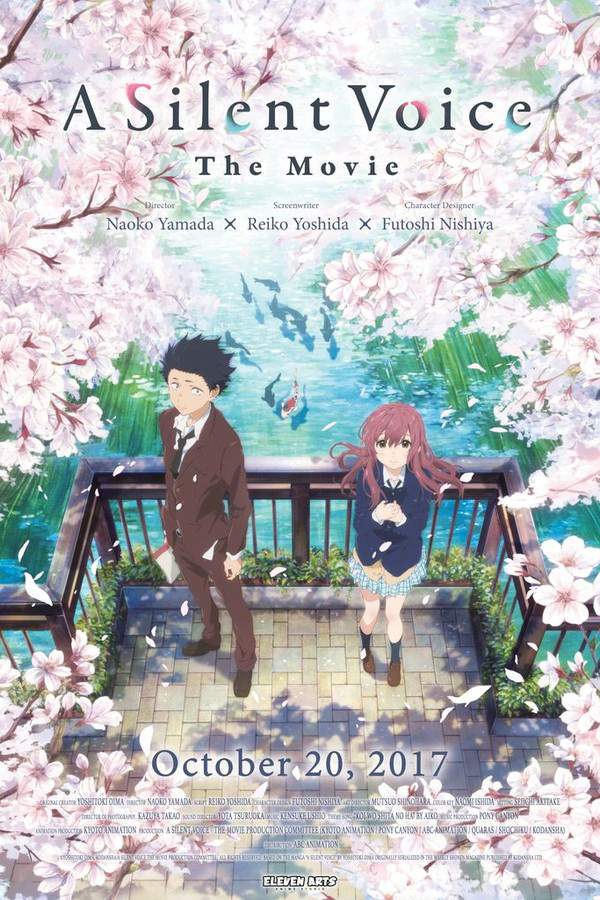A Silent Voice 2017

A former bully seeks redemption when he attempts to reconnect with a deaf girl he tormented in childhood. Years later, Shōya Ishida must confront his past actions and the pain he caused, while also grappling with his own struggles with isolation and self-loathing. The film follows his journey toward understanding and empathy, exploring the complexities of adolescence and the possibility of forgiveness.
Does A Silent Voice have end credit scenes?
No!
A Silent Voice does not have end credit scenes. You can leave when the credits roll.
Meet the Full Cast and Actors of A Silent Voice
Explore the complete cast of A Silent Voice, including both lead and supporting actors. Learn who plays each character, discover their past roles and achievements, and find out what makes this ensemble cast stand out in the world of film and television.
External Links and Streaming Options
Discover where to watch A Silent Voice online, including streaming platforms, rental options, and official sources. Compare reviews, ratings, and in-depth movie information across sites like IMDb, TMDb, Wikipedia or Rotten Tomatoes.
Ratings and Reviews for A Silent Voice
See how A Silent Voice is rated across major platforms like IMDb, Metacritic, and TMDb. Compare audience scores and critic reviews to understand where A Silent Voice stands among top-rated movies in its genre.

The Movie Echo Score
In terms of its overall impact, A Silent Voice excels in merging emotional depth with a thoughtful narrative and striking visuals. The film’s direction and cinematography employ dynamic framing and painterly backgrounds to underscore the protagonist’s inner turmoil. Characters are rendered with subtle expressiveness, while the story’s measured pacing unfolds a redemptive arc grounded in realism. Sensory details in sound design and animation further enhance the immersive experience. These combined elements yield a resonant, repeat-worthy anime with a lasting impression.
The Movie Echo Score Breakdown for A Silent Voice

Art & Craft
In terms of visual craft, A Silent Voice demonstrates inventive direction and meticulous production design. The use of dynamic camera angles and painterly backgrounds creates a real sense of place and visual cohesion. Elements like the superimposed purple Xs and measured editing underscore character psychology. Overall, the film’s artfulness consistently supports its emotional narrative.

Character & Emotion
When it comes to character and emotion, A Silent Voice offers nuanced portrayals of its protagonists. Expressive animation conveys internal states without reliance on dialogue, while attention to subtle gestures and facial cues reveals depth. The narrative’s focus on redemption and empathy generates genuine emotional resonance. In sum, character work forms the emotional core of the film.

Story & Flow
In terms of story and flow, the film presents a coherent redemption arc that explores bullying, self-loathing, and the search for forgiveness. Measured pacing balances introspective scenes with key narrative milestones, though some viewers may find the emotional investment demanding. Plot progression remains engaging through expert narrative weaving and a clear sense of stakes. Overall, the story offers a satisfying and authentic journey.

Sensory Experience
When it comes to sensory experience, A Silent Voice excels in sensitively crafted audio and visual design. The sound design and score subtly underscore emotional beats, while the delicate animation style offers a cohesive and sensuous atmosphere. Visual details, including subdued color palettes and focused framing, enhance mood without overwhelming the narrative. Overall, the film delivers an immersive sensory environment.

Rewatch Factor
In terms of rewatch factor, the film’s emotional depth and thematic resonance encourage repeat viewings. The layered narrative and character evolution reveal new subtleties on subsequent watches, while the immersive audiovisual design reinforces the experience each time. Viewers frequently report lingering reflections and a renewed appreciation for the film’s craft. In sum, A Silent Voice offers strong lasting appeal.

78
Metascore
8.8
User Score


95%
TOMATOMETER

94%
User Score

6.8 /10
IMDb Rating

84
%
User Score

4.2
From 25K fan ratings
Take the Ultimate A Silent Voice Movie Quiz
Challenge your knowledge of A Silent Voice with this fun and interactive movie quiz. Test yourself on key plot points, iconic characters, hidden details, and memorable moments to see how well you really know the film.
A Silent Voice Quiz: Test your knowledge on the poignant themes and events of 'A Silent Voice' from 2017.
What is the main struggle of Shōya Ishida in the film?
His passion for painting
His past as a bully and seeking redemption
His relationship with his family
His academic performance
Show hint
Full Plot Summary and Ending Explained for A Silent Voice
Read the complete plot summary of A Silent Voice, including all major events, twists, and the full ending explained in detail. Explore key characters, themes, hidden meanings, and everything you need to understand the story from beginning to end.
An elementary school student, Shōya Ishida, along with his friends, cruelly bullies Shōko Nishimiya, a new classmate who is deaf. As the bullying escalates, the principal learns of the situation, but in a twist of fate, Shōya’s friends turn on him, framing him as the primary instigator. This leads to a confrontation between the two, ultimately causing Shōko to transfer to another school, while Shōya keeps her notebook as a memento.
Transitioning into middle school, the stigma of being labeled a bully haunts Shōya, causing him to retreat into a shell of loneliness and depression. He contemplates suicide but resolves to seek redemption by mending relationships and apologizing to those he’s harmed before taking that drastic step. This journey of atonement brings him full circle to Shōko, where he returns her notebook at the sign language center she attends, only to discover that she is still deeply lonely and reserved.
In this new chapter, Shōya forms a friendship with Tomohiro Nagatsuka, a fellow outcast who feels a sense of gratitude towards him for standing up against bullying. Attempts to help Shōko find joy in the little things lead to friction with her younger sister, Yuzuru. A series of misunderstandings escalates when Shōya jumps into the river to retrieve Shōko’s notebook, only for Yuzuru to take a photo of the moment and use it against him, resulting in his suspension.
As the story unfolds, Shōya strives to reconnect Shōko with former friends, including Miyoko Sahara, a compassionate peer, and Naoka Ueno, who has a dubious history of bullying. Relationships entangle further when Miki Kawai enters the scene, rekindling connections while also revealing secrets that cast shadows on their friendships.
After navigating the complexities of emotion and misunderstanding, Shōya invites Shōko on a group outing to an amusement park, where tensions flare and emotions boil over, causing a fallout among friends. As the weight of their shared past presses down on him, Shōya turns inward, finding solace only in his bond with the Nishimiya sisters.
During a poignant fireworks festival, a moment of despair drives Shōko to the brink. Shōya races to stop her from jumping and, in the process, ends up injured and comatose. In a dreamlike encounter, Shōko is visited by Shōya, where he finally voices his regrets, urging her not to carry the burden of guilt for his struggles.
When Shōya awakens, he must confront both his past actions and his future. His journey leads him back to the bridge where he finds Shōko grieving. In a heartfelt exchange, he offers apologies and reconciliation, vowing to embrace life with her support.
Returning to school, Shōya experiences overwhelming joy as he reunites with his friends, realizing that their care for him remains strong. As they head to the school festival together, tears of gratitude and relief flow as Shōya understands that he has begun to find redemption and healing in the connections he’s sought to rebuild.
Uncover the Details: Timeline, Characters, Themes, and Beyond!

Coming soon on iOS and Android
The Plot Explained Mobile App
From blockbusters to hidden gems — dive into movie stories anytime, anywhere. Save your favorites, discover plots faster, and never miss a twist again.
Sign up to be the first to know when we launch. Your email stays private — always.
Watch Trailers, Clips & Behind-the-Scenes for A Silent Voice
Watch official trailers, exclusive clips, cast interviews, and behind-the-scenes footage from A Silent Voice. Dive deeper into the making of the film, its standout moments, and key production insights.
A Silent Voice Other Names and Titles
Explore the various alternative titles, translations, and other names used for A Silent Voice across different regions and languages. Understand how the film is marketed and recognized worldwide.
Quick Links: Summary, Cast, Ratings, More

What's After the Movie?
Not sure whether to stay after the credits? Find out!
Explore Our Movie Platform
New Movie Releases (2025)
Famous Movie Actors
Top Film Production Studios
Movie Plot Summaries & Endings
Major Movie Awards & Winners
Best Concert Films & Music Documentaries
Movie Collections and Curated Lists
© 2025 What's After the Movie. All rights reserved.
























